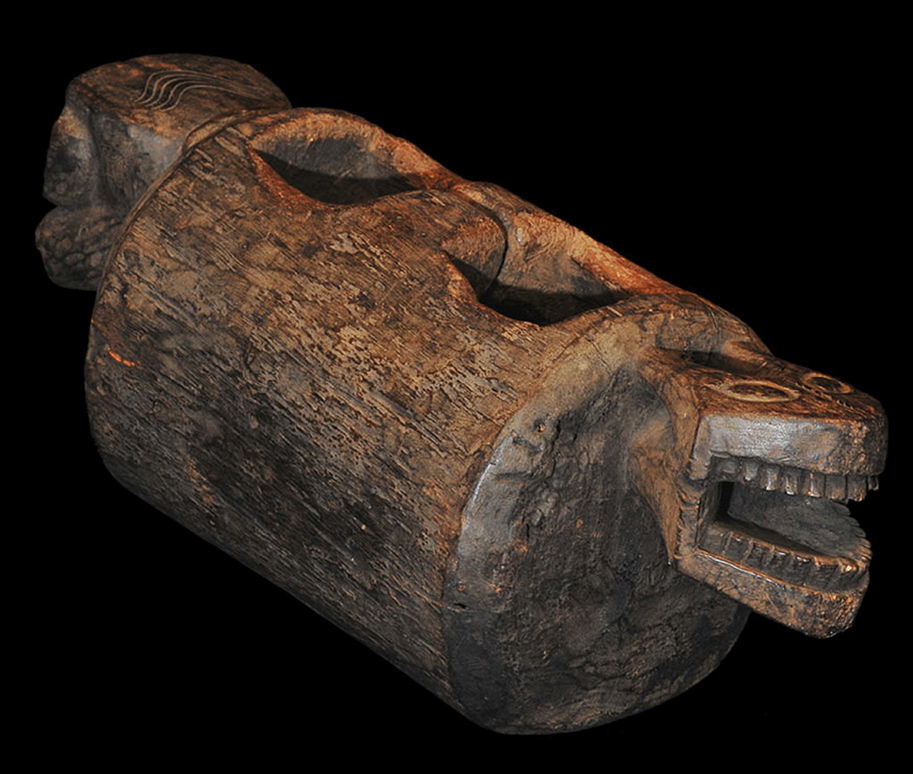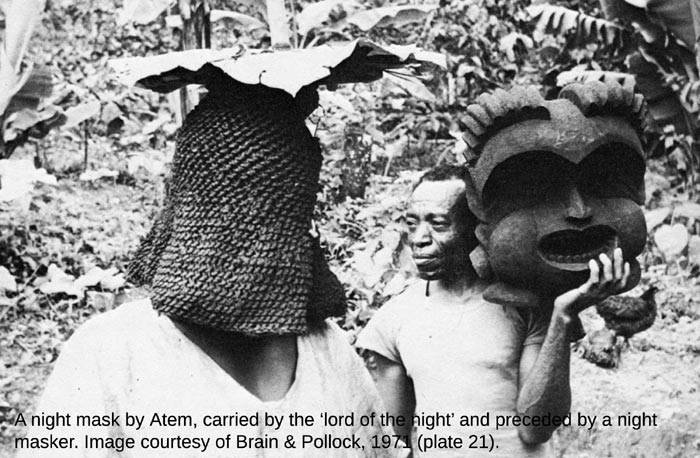DRUMS OF THE WORLD
Africa
bangwa slit drum cameroon
Bangwa slit drum ( Schlitztrommel / Tambour à fente ) Cameroon
"Among musical instruments of the Cameroon Grassfields, slit gongs thus span a large spectrum of forms and uses. Their association with chiefship and the activity of warfare, with powerful secret societies, as well as in a more lighthearted sense with dance and entertainment, transforms them into meaningful symbols transcending their nature as idiophones that send messages or keep the beat."
Excert from: Sounding forms: African musical instruments - edited by Marie-Thérèse Brincard. The American Federation of Arts,1989
Part VII: Christraud M. Geary – Slit Gongs in the Cameroon Grassfields: Sights and Sounds of Beauty and Power.
"The three most common slit drum types are the cylindrical, the trapezoid and the zoomorphic. Besides these we also find them in the form of a tulip, half-moon and boat. The basic structure of the drum is virtually the same for each type and is best illustrated by the cylindrical slit drum. A block of wood, usually part of a tree trunk, is cut into the desired shape and then hollowed out through the slit in the upper side. The drum-maker/woodcutter ensures that the two sides of the drum are unequal in thickness so that different pitches are produced when played with two rubber-headed drum sticks. The two-tone structure will later form the basis for the transmission of a message, the purpose for which these instruments are best known. The creativity of the drum-maker and woodcutter is clearly visible in the way the upper side around the slit is decorated. This can be done by making the simple cut for the slit and by adding two "sound holes" at each end, or by decorating the area around the slit with geometric patterns."
Copyright © Royal Museum for Central Africa ('RMCA'), 2018. All rights reserved.
excerpt from the website:http://music.africamuseum.be/instruments/english/congo%20drc/bakpekpe.html
Bei den Schlitztrommeln im Kameruner Grasland findet sich ein weites Spektrum an Formen und Verwendungen.
Sie stehen meist im Zusammenhang mit dem Häuptling- Königstum, Geheimgesellschaften, aber auch mit Tanz und Unterhaltung.
Bei den Bangwa werden die trommeln mit „alaling“ assoziiert, eine Krieger und Geheimgesellschaft. Die Schlitztrommeln werden während der „alaling“ Maskentänze von Mitgliedern der Gesellschaft gespielt.
(vgl. Brincard S.69)
Bibliography:
Ankermann, B. - Die afrikanischen Musikinstrumente
Bebey, Francis. African Music: A People's Art. New York: Lawrence Hill, 1975
Brincard, M.T. : Sounding Forms – African Musical Instruments 1989
Dagan , Esther A. - Drums : The Heartbeat of Africa edited by Galerie Amrad 1993
Kubik, Gerhard – Musikgeschichte in Bildern : Westafrika. Leipzig 1989
Meyer, Andreas : Afrikanische Trommeln – West- und Zentralafrika. Staatliche Museen Preußischer Kulturbesitz, Berlin 1997
Wieschhoff, Heinz : Die afrikanischen Trommeln und ihre außerafrikanischen Beziehungen. Stuttgart 1933
"Among musical instruments of the Cameroon Grassfields, slit gongs thus span a large spectrum of forms and uses. Their association with chiefship and the activity of warfare, with powerful secret societies, as well as in a more lighthearted sense with dance and entertainment, transforms them into meaningful symbols transcending their nature as idiophones that send messages or keep the beat."
Excert from: Sounding forms: African musical instruments - edited by Marie-Thérèse Brincard. The American Federation of Arts,1989
Part VII: Christraud M. Geary – Slit Gongs in the Cameroon Grassfields: Sights and Sounds of Beauty and Power.
"The three most common slit drum types are the cylindrical, the trapezoid and the zoomorphic. Besides these we also find them in the form of a tulip, half-moon and boat. The basic structure of the drum is virtually the same for each type and is best illustrated by the cylindrical slit drum. A block of wood, usually part of a tree trunk, is cut into the desired shape and then hollowed out through the slit in the upper side. The drum-maker/woodcutter ensures that the two sides of the drum are unequal in thickness so that different pitches are produced when played with two rubber-headed drum sticks. The two-tone structure will later form the basis for the transmission of a message, the purpose for which these instruments are best known. The creativity of the drum-maker and woodcutter is clearly visible in the way the upper side around the slit is decorated. This can be done by making the simple cut for the slit and by adding two "sound holes" at each end, or by decorating the area around the slit with geometric patterns."
Copyright © Royal Museum for Central Africa ('RMCA'), 2018. All rights reserved.
excerpt from the website:http://music.africamuseum.be/instruments/english/congo%20drc/bakpekpe.html
Bei den Schlitztrommeln im Kameruner Grasland findet sich ein weites Spektrum an Formen und Verwendungen.
Sie stehen meist im Zusammenhang mit dem Häuptling- Königstum, Geheimgesellschaften, aber auch mit Tanz und Unterhaltung.
Bei den Bangwa werden die trommeln mit „alaling“ assoziiert, eine Krieger und Geheimgesellschaft. Die Schlitztrommeln werden während der „alaling“ Maskentänze von Mitgliedern der Gesellschaft gespielt.
(vgl. Brincard S.69)
Bibliography:
Ankermann, B. - Die afrikanischen Musikinstrumente
Bebey, Francis. African Music: A People's Art. New York: Lawrence Hill, 1975
Brincard, M.T. : Sounding Forms – African Musical Instruments 1989
Dagan , Esther A. - Drums : The Heartbeat of Africa edited by Galerie Amrad 1993
Kubik, Gerhard – Musikgeschichte in Bildern : Westafrika. Leipzig 1989
Meyer, Andreas : Afrikanische Trommeln – West- und Zentralafrika. Staatliche Museen Preußischer Kulturbesitz, Berlin 1997
Wieschhoff, Heinz : Die afrikanischen Trommeln und ihre außerafrikanischen Beziehungen. Stuttgart 1933


